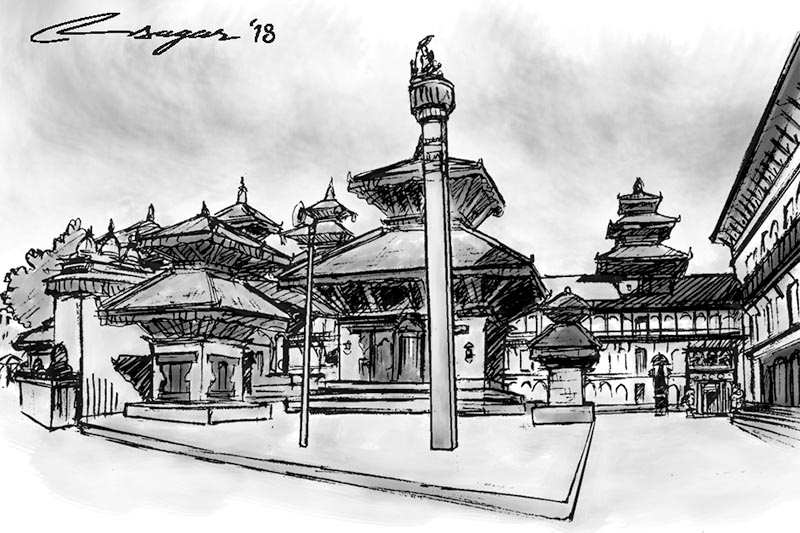Sustainable development: What are Valley’s priorities?
The Kathmandu Valley as a whole is recognised as a world heritage site, which has a great potential to attract tourists in large numbers. But unfortunately, rapid urbanisation and pollution have been a setback for the travel and tourism sector
The dream of the mayor of Kathmandu Metropolitan City is to construct a monorail and the metro inside the city, whereas Prime Minister KP Oli sold the dream of installing cooking gas lines to provide an uninterrupted supply of gas to the people in order to ultimately phase out the gas cylinders.
Social media users found their own ways to mock these lofty promises.
It looks like those promises were made without realising the ground reality of the Kathmandu Valley and its denizens.
The Valley is grappling with many basic problems. Sanitary issue appears on the top. The Valley is already brimming with the population. Pollution is yet another problem due to the rising number of vehicles. And then there is dust pollution.
It is but one’s individual freedom to have some sort of dreams, but the present leadership needs to have a vision for sustainable development of the Valley as well as the rest of the country.
The Kathmandu Valley as a whole is recognised as a world heritage site, which has a great potential to attract tourists in large numbers. But unfortunately, rapid urbanisation coupled with pollution has been a setback for the tourism sector. Not very many international tourists want to stay in and travel around the Kathmandu Valley for obvious reasons.
Development should not be viewed through the narrow lens of rapid construction of bigger roads and infrastructure; rather focus should be on sustainable development. Sustainable development takes a backseat when cultivable lands are lost to haphazard urbanisation when we try to build new cityscape.
The Kathmandu Valley has little resources and if the power of the Capital is decentralised, tourism may only be a viable source of its economy. In order to achieve the greater dream, the population of the Kathmandu Valley has to be managed. Developing monorail and metro inside the Valley may only contribute in pouring more people into the already overcrowded city where land prices have skyrocketed.
The government effort to take control over land ignites a fierce competition as each inch of land is worth a fortune. Therefore, efforts for development should be made for the regions which are in urgent need of infrastructure.
Districts around the Valley have great potential for growth and the project of metro could be more productive in those regions. It may be a long journey for these areas to develop and the development scheme of Nepal is so gradual that we could develop the region side by side with the plans for metro, which would make metro a viable option to collect revenue once it is completed.
If the metro tracks are strategically planned with a promising future, many investors and independent citizens would like to buy land and build infrastructure in regions where prices are expected to go up.
This would contribute more to Nepali economy. Simply building an outer ring road or a fast-track to connect the Kathmandu Valley with the rest of the country will not work in the long run.
It is our need to build infrastructure in a comfortable distance that would decrease the population and traffic density of the Valley and the local government can emphasise promoting the Valley as a tourist destination. We can create new cities beyond the borders of the Valley, but we can’t create traditional heritage in places of our choice.
In order to achieve sustainable development, Nepal needs to focus on completing hydropower projects. Once the country has sufficient energy, people can choose electricity as fuel for cooking. This can save a huge amount of money which will be required for installing cooking gas pipelines. Similarly, focus then would shift towards electric vehicles, decreasing our dependence on fossil fuels.
The government also then must focus on building industries and promoting the production sector, which can address the problem of ballooning trade deficit.
The real power of the government may depend on its capacitance of adding and reducing tax which could encourage investors to invest in sectors which earlier were neglected. High tax discourages investors from putting money in the Nepali market. Lack of employment opportunities then will continue to force many youths to go abroad for jobs.
Managing waste is a basic issue, but garbage has become a headache for the mayor’s office. The metropolis can address the garbage woes by introducing new schemes for companies that recycle and reuse waste to create new products. Such industries should be promoted by creating a conducive environment for them.
We need to adopt a multi-pronged approach to achieve sustainable development.
The state needs to develop remote parts of Nepal than building more infrastructure and roads inside an area which must be protected for the natural landscape. The state ought to choose technology that helps to decrease import and support in establishing local companies in sectors which would manage our waste, create job opportunities and promote national heritage.
Amatya, a graduate in international relations from Jilin University, Changchun, China, is a member of Save Nepa Valley Movement






